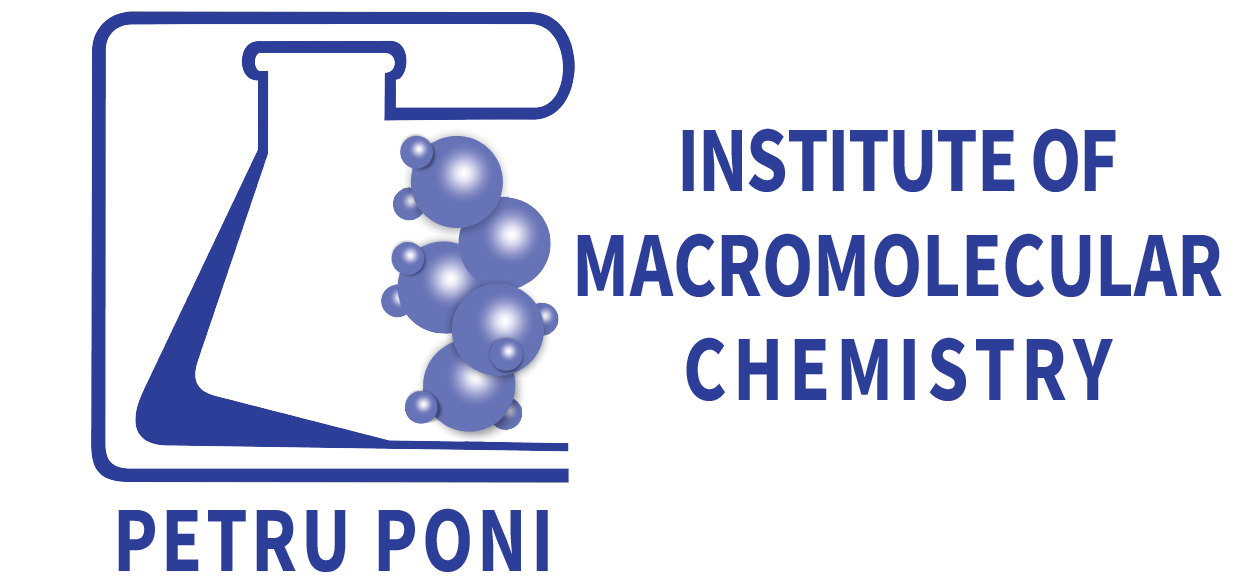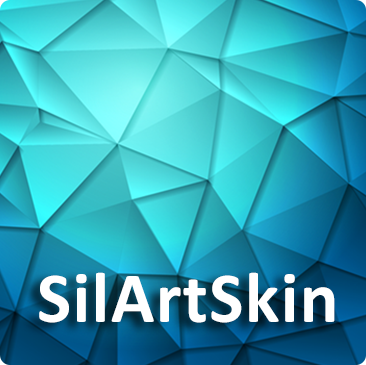|
Project Scope and Objectives
The main goal of the project was to develop a method for detecting and evaluating damage caused by MMOD (micrometeoroids and orbital debris) impact, providing the possibility of using it on spacecraft in low Earth orbit (LEO). The method is based on polymer capacitive sensors that are permanently "alive", providing real-time details to the user about the structural integrity of the spacecraft, even if penetration occurs. A sensor, or a dielectric elastomer transducer (DETs), consists of an elastic polymer membrane covered on both sides with electrodes. Several sensors form a module, and multiple modules form a network for detecting and evaluating damage caused by mechanical impact, acting as an "artificial skin".
The first objective (CO I) proposed aims at developing the constituent materials of the proposed technology. The objective aimed to optimize the materials that will be used in obtaining the proposed technology in the project: a modular network of polymer sensors for detecting and evaluating the impact from MMOD. The optimization of the self-repairing silicone elastomer and the metallic electrodes was pursued, and their testing was conducted before and after exposure to accelerated aging and irradiation with various types of radiation
|
The optimization of the self-repairing silicone elastomer was performed by varying the ratio between the chemical groups that provide the self-repairing effect. Thus, the ratio between the amino groups (represented schematically in blue) was varied through the synthesis of six siloxane copolymers, while the number of carboxylic groups (represented schematically in green) of the cross-linking agent remained constant. The elongation at break is influenced by the ratios used, resulting in better mechanical properties when a higher percentage of amino groups is used, but the self-repair properties are faster and better when a larger amount of cross-linking agent is used (Experiment 2 and 4). After 10 days of contact, approximately all samples regain their mechanical properties to about 80%. After accelerated aging (using the CH 250E apparatus from Angelantoni Industry - 27 days at 40 degrees Celsius, 60% relative humidity, and irradiation with UV-A, UV-B, UV-C ultraviolet rays, with an intensity of 39 W/cm2), and irradiation with protons (installation: 3 MV Tandetron, dose: 5x1013 atoms/cm2 and an energy of 3 MeV, dose: 5x1013 atoms/cm2 and an energy of 5 MeV) the mechanical properties decrease dramatically, but samples 1 and 2 have the fastest self-repair capacity. After 10 days of contact, the samples regain their mechanical properties to about 20-30%. The materials and the manufacturing process formed the basis of a patent application (A00101, 12.03.2024).
|
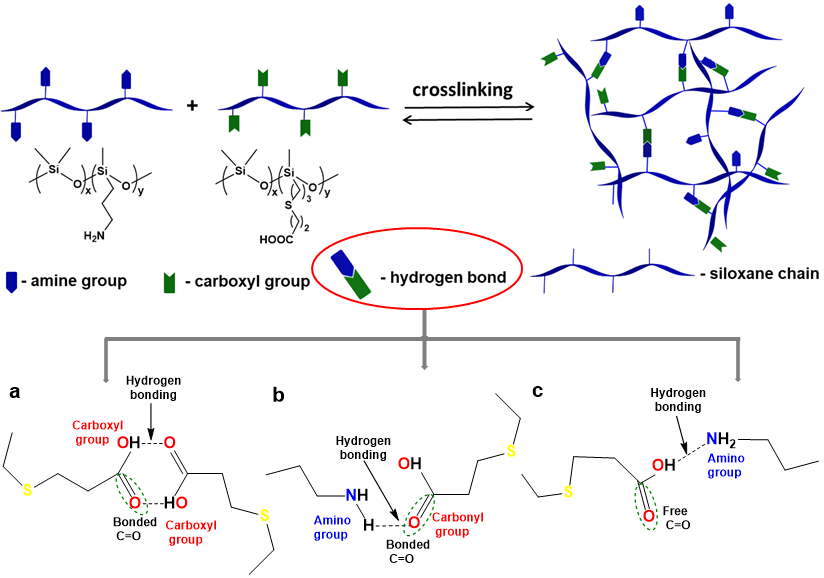
|

|
The investigation of copper and gold electrodes deposited by high-power impulse magnetron sputtering (HI-PIMS) aims to optimize the metallic electrodes used in the manufacturing of the proposed technology within the project. Copper electrodes do not remain conductive after accelerated aging, so the study continued involving gold electrodes. Electrical conductivity was determined using an installation developed within the project, which allows the determination of electrical conductivity at different elongations. The electrical conductivity remains approximately the same as those obtained on commercial elastomers. Gold electrodes deposited exhibit conductivities at elongations of up to 8-12% (without surface substrate treatment). The optimized electrodes at this stage were used in manufacturing sensor modules and form the basis of a patent application under examination (A100664, 08/11/2023).
|
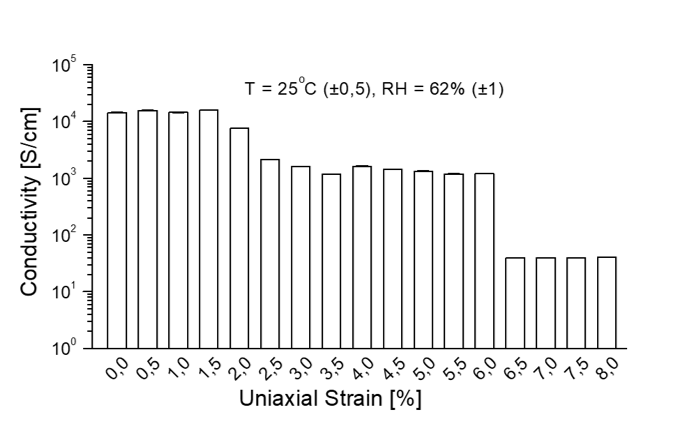
|
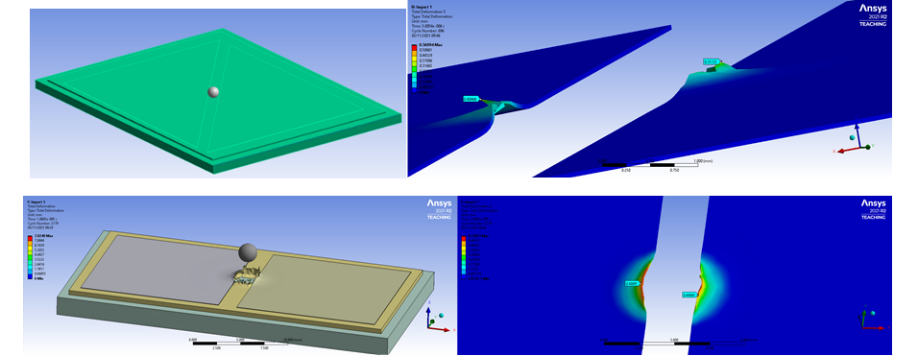
|
The second proposed objective (CO2) aimed to select the shape of the sensor module in order to minimize inactive areas and to test them as force (pressure) sensors after exposure to extreme conditions.
For this purpose, CAD design, as well as FEA simulations, provided sufficient information for choosing a shape that would allow the creation of sensor modules with minimal inactive areas and be capable of easily connecting to each other without adding additional technological effort or inactive surface. The shapes identified as optimal for the intended purpose were: rectangular shape for the elastomer and electrodes; - hexagonal shape for the elastomer, and triangular shape for the electrodes.
|
|
Sensor modules were constructed following a simple procedure, and a patent application was filed for examination (A100664, 08/11/2023), using the previously optimized materials. A Keysight U1733P Handheld LCR and a CETR UMT-2 Tribometer were used to correlate capacitance with force. Thus, capacitance-applied force correlation tests (calibration) were conducted on sensor modules with gold electrodes. Responses were obtained for forces up to 20 N (the maximum offered by the device), with pressures of up to 116 kPa after applying forces with a 12 mm diameter disc. The sensor exhibits good sensitivity, a resolution of 3 N, and does not present substantial drift over time.
|

|

The sensor modules with optimized materials retained their integrity, thus providing the ability to respond to mechanical impact even after accelerated aging, proton irradiation, and exposure to temperatures of up to 180 degrees Celsius.
(Accelerated aging: CH 250E apparatus from Angelantoni Industry - 27 days at 40 degrees Celsius, 60% relative humidity, and irradiation with UV-A, UV-B, UV-C ultraviolet light at an intensity of 39 W/cm2; proton irradiation: 3 MV Tandetron facility, dose: 5x1013 atoms/cm2 and energy of 3 MeV and 5 MeV). The sensor module with commercial materials, as a reference, did not retain its integrity, losing the ability to respond to mechanical impact.
The response of a sensor obtained with optimized materials before (a) and after (b) accelerated aging, proton irradiation, and exposure to extreme temperatures.
OBJECTIVE 3 (CO III) aimed to demonstrate the proposed technology by assembling multiple sensor modules and implementing dedicated software. The sensor modules can provide details to the operator (location, impact time, capacitance variation) thanks to specially designed software. A Class U spacecraft was designed, a 10 cm cube nano-satellite containing rectangular sensor modules. Thus, a 3D prototype of a Class U spacecraft was printed, onto which four rectangular modules were mounted on four sides, along with solar panels. The software was adapted to provide information to the user for all four sides, including color variations and real-time graphics.
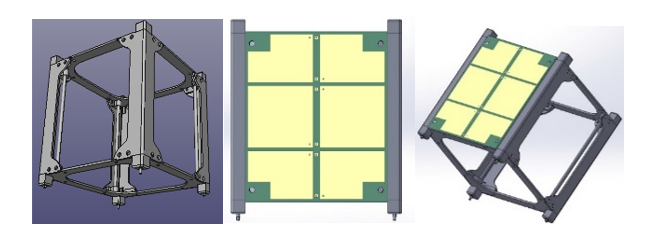


The impact of implementing the project:
The development of the project had a significant impact on the scientific community by initiating two other related projects, one aimed at developing a platform for irradiation according to LEO conditions (PN-IV-P7-7.1-PED-2024-2029 - An innovative ion irradiation platform for exploring the resilience of nano-satellites to space radiation) and another one in which the technological maturity achieved by the development of the present project, PN-III-P1-1.1-TE-2021-0156, will reach TRL 7 through the implementation of a project that includes transfer to the economic operator (PN-IV-P7-7.1-PTE-2024-0444 - PocketShield - Self-repairing impact sensors for the space industry). During the development of the project, a team member, PhD candidate Bianca-Iulia Ciobotaru, accumulated experimental data for the completion of her doctoral thesis and its public defense (https://icmpp.ro/theses_announcements.php). Thus, an important objective of the project is achieved: the establishment of a laboratory for prototyping polymer sensor modules capable of being used as a method of detecting damage caused by MMOD with applications in aerospace engineering through the acquisition of state-of-the-art equipment and the consolidation of a young, independent team capable of implementing a technology from TRL 1 to TRL 4 (proof-of-concept).
|
